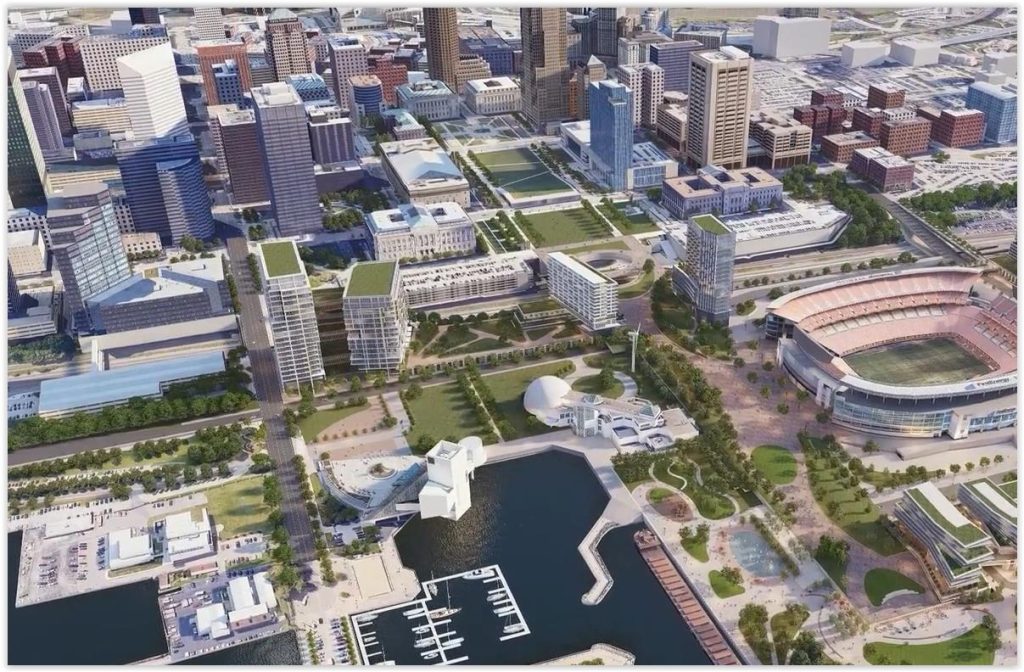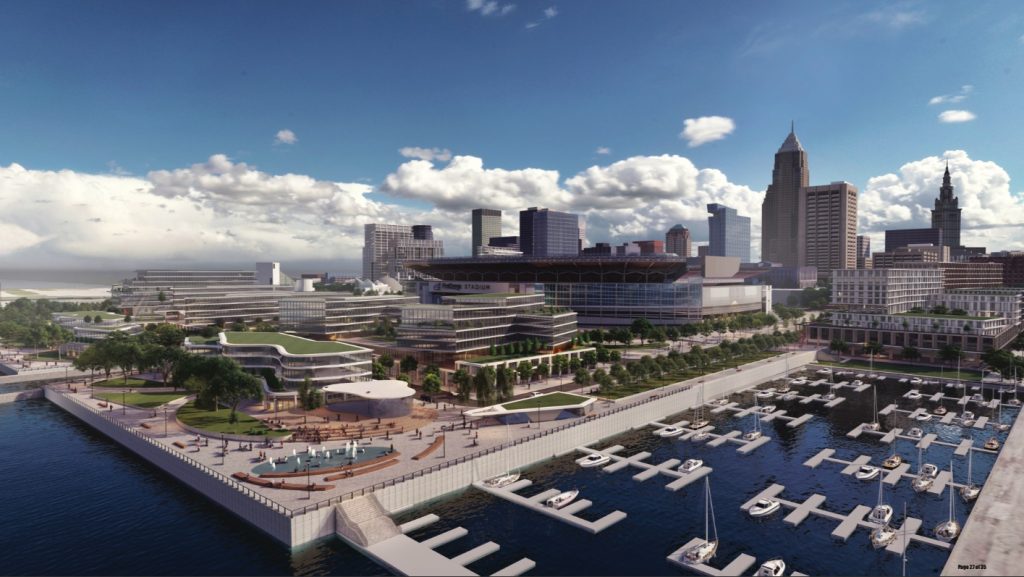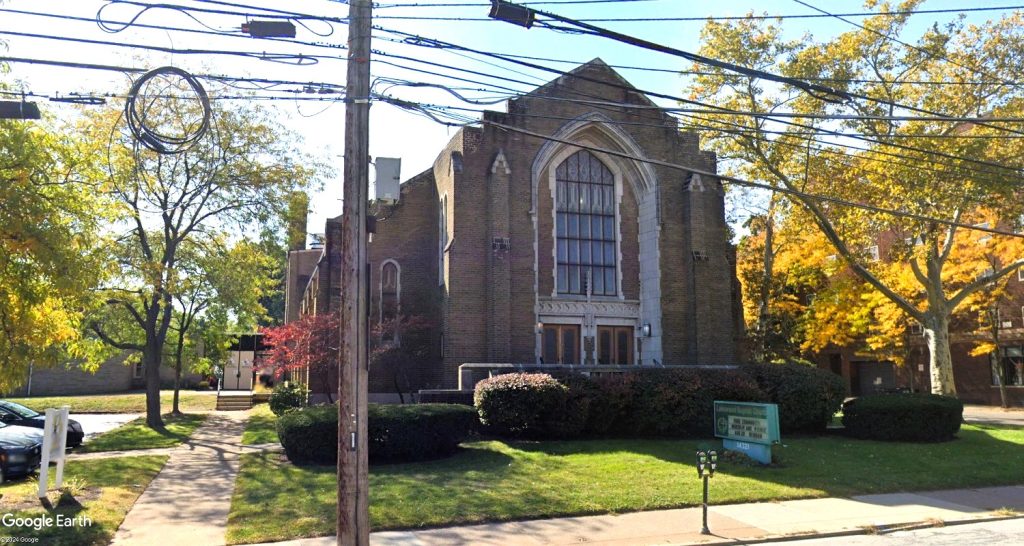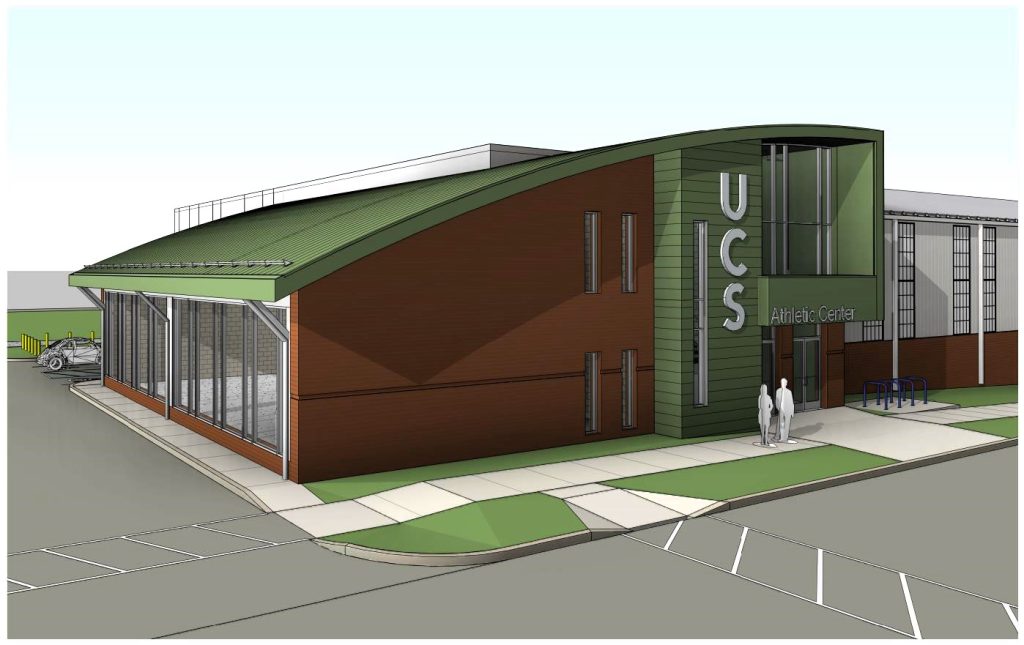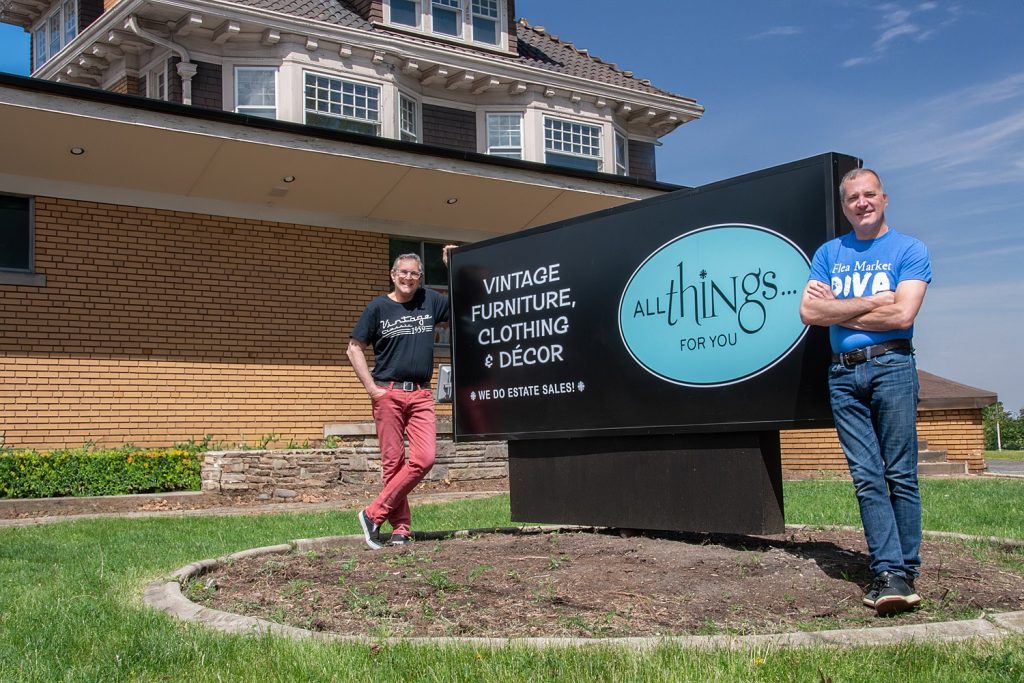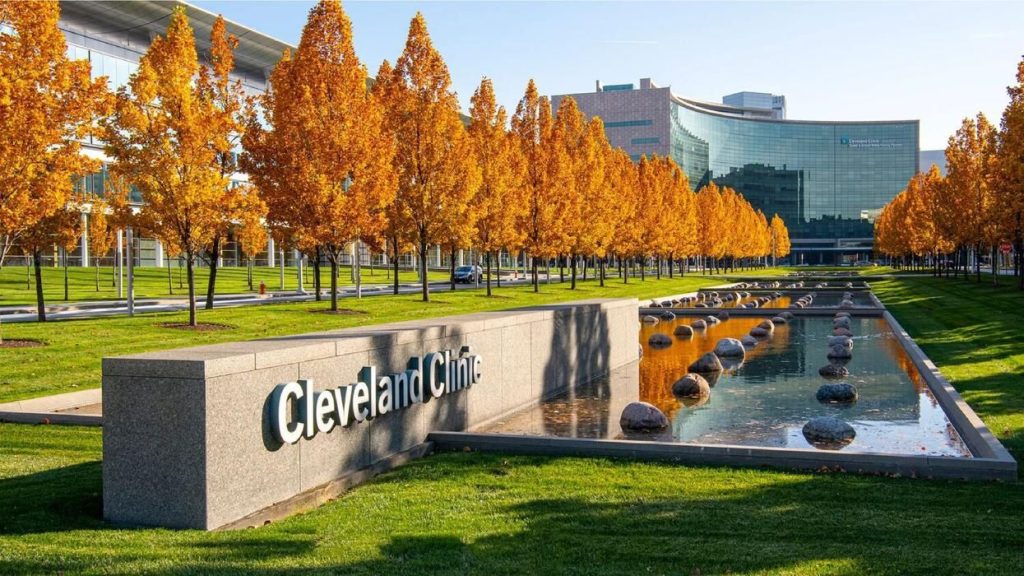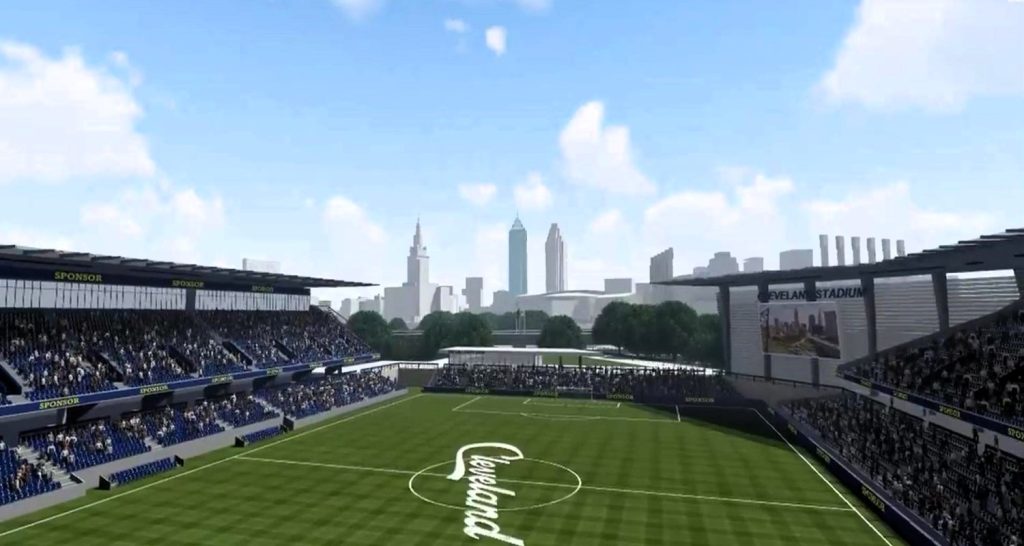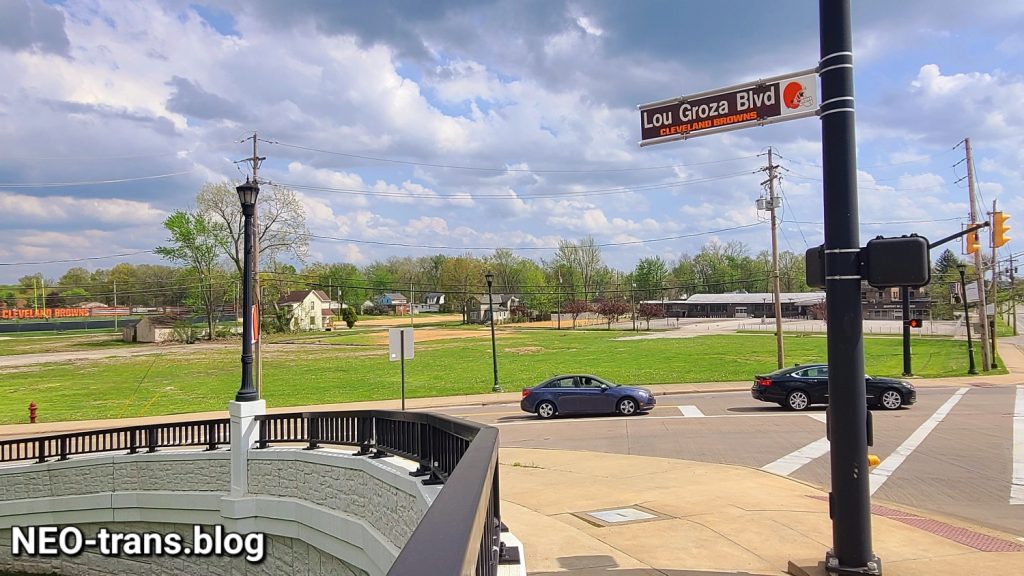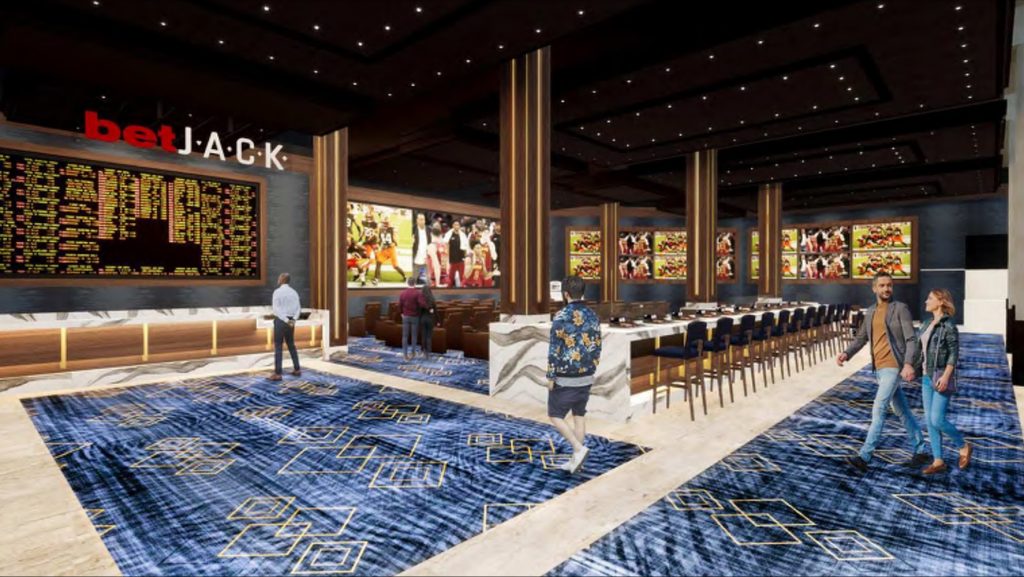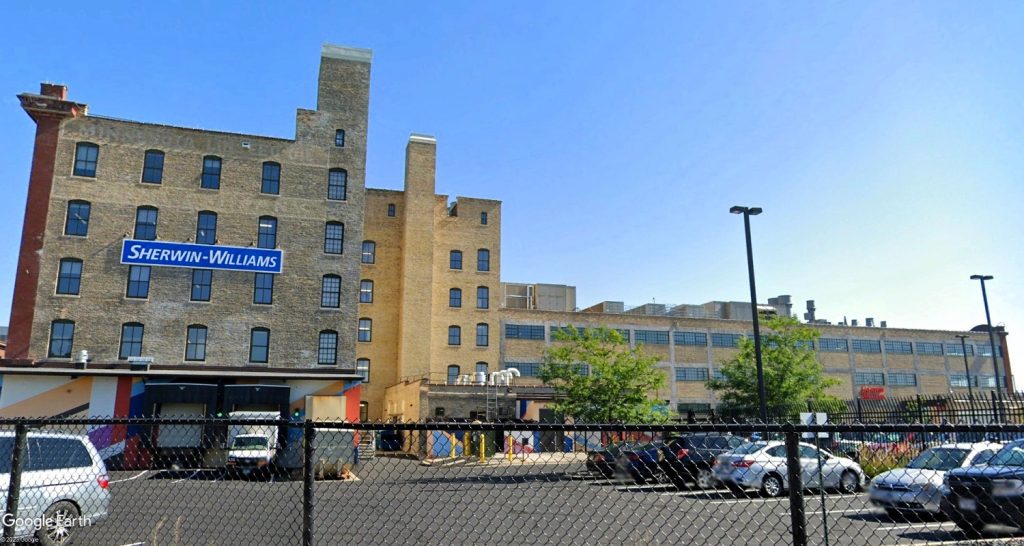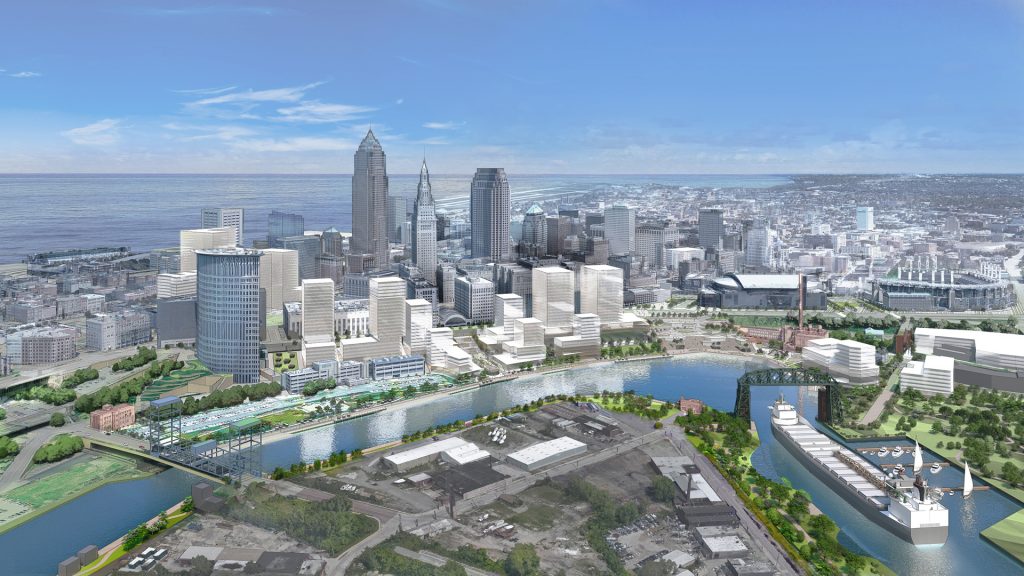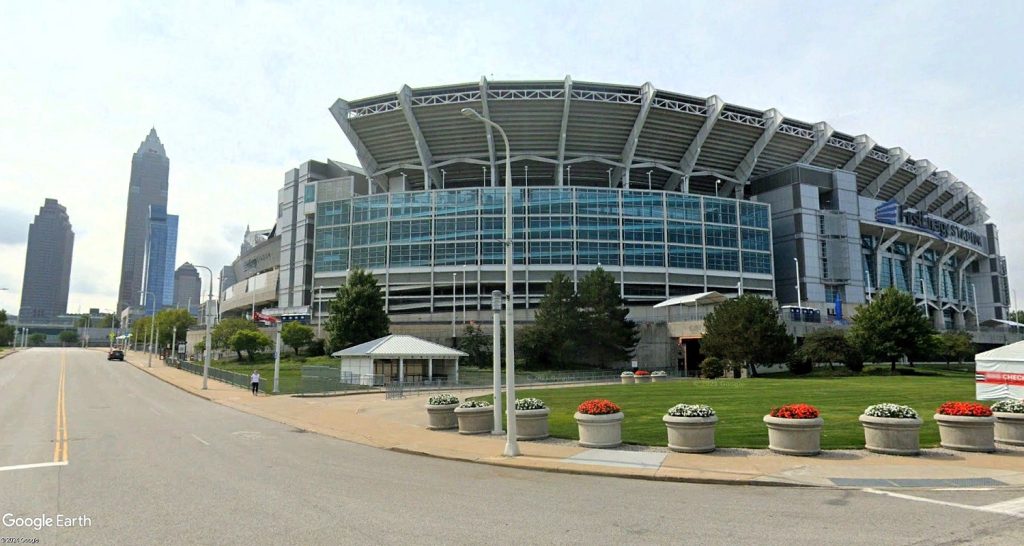
Cleveland Browns Stadium sets on 30 acres of prime downtown lakefront land, but for how long? City officials and Browns ownership have differing views on how the land around the stadium should be used, prompting the Haslams to look elsewhere for its next home venue. City officials seem okay with that (Google). CLICK IMAGES TO ENLARGE THEM.
City sees social justice, Haslams see ROI in lakefront
A COMMENTARY
As the old saying goes, “Show me your budget — I will tell you what you value.” Along those same lines, if you want to know what Cleveland city officials vs. the owners of the Cleveland Browns want from their returns on investment in the lakefront, show me your actions, not your words.
The fact that the Haslam Sports group, owners of the Browns, have a purchase agreement for 176 acres of land in suburban Brook Park less than five years before the Browns’ lease at city-owned Cleveland Browns Stadium is due to expire is a telling action. If negotiations were going well regarding the stadium’s future, we would never have heard about Brook Park being an option.
Something has obviously not gone the Browns’ way to bring us to that point. And that’s only one of many “tells” in this poker match that speaks louder than words. At the end of the day, it all boils down to what each side wants out of a redeveloped downtown lakefront.
What the Cleveland Browns and its owners, the Haslam Sports Group, want from the city of Cleveland the city does not want to give. The Haslam appear to want to build a Browns version of Disney World — like Dallas Cowboys’ owner Jerry Jones built Jerry’s World including and surrounding AT&T Stadium in suburban Arlington, TX.
Owners Jimmy and Dee Haslam wanted to build Jimmy’s World on the lakefront with high-end apartments, hotels, shops and valet parking as their renderings by Lakewood-based AODK Architecture from two years ago showed. In short, they want the market to drive the development because they, as a private-sector firm, understandably want to make money from it. A privately developed waterfront is going to be prime land and carry a high value along with it.
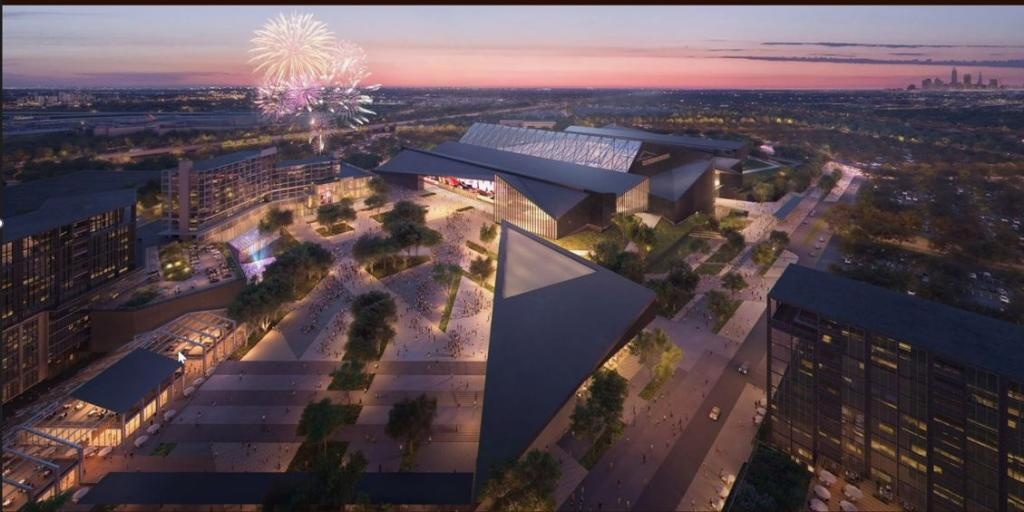
A future Cleveland Browns domed stadium in suburban Brook Park is proposed to be surrounded by apartment buildings, hotels, shops, restaurants, entertainment, public plazas, new streets and more. The Browns wanted this on the lakefront but the Bibb Administration chose to go in a different direction (anonymous).
That’s not what Mayor Justin Bibb’s administration wants from the downtown lakefront. Their values are based on a different set of experiences and backgrounds. He and his chiefs want it accessible to all Clevelanders. They want the lakefront to be a place that people of all incomes, races and backgrounds can enjoy equally.
Bibb’s vision statement about the lakefront became clear at the unveiling of the city’s conceptual lakefront plan in July 2023. As a young African-American who grew up in Cleveland’s impoverished, nearly all-black Mount Pleasant neighborhood, Bibb said he didn’t visit the lakefront in his own city until he was in high school.
“The lakefront was seen as a place for rich, white folks,” he said. “This (lakefront) plan wasn’t formed in a board room. It was formed with input of the people who would use it. Cleveland is one of the most segregated cities in the country. The river and the lake were part of that as dividing lines. We’re proposing a lakefront that is a place of healing.”
Last year, the city contracted with FUSE, a Boston-based nonprofit whose mission is to free the country from social and economic barriers to opportunities that have been perpetuated by a history of systemic and institutionalized racism. FUSE is helping the city shape its plans for a redeveloped lakefront.
The city’s lakefront plans don’t contain luxury apartment towers, glamorous hotels, white-tablecloth restaurants and shops where you need to check your credit card balance before you buy anything. Instead it has lawns, fishing piers, amphitheater, cookout settings, beaches, sports courts, kayak launch, wetlands and other natural features. Those things don’t cost much if anything to use.
There is housing and some shops plus a small cruise ship terminal planned. These comprise a comparatively small portion of the lakefront vision. Updates on the planning work were due to be released in January. But the planning has not advanced much lately, at least publicly, until the city gets clarity on the stadium situation.
It is clear that city officials don’t want to lose the Browns. On Monday, Cleveland City Council passed its own version of the so-called Modell Law and awaits Bibb’s signature. It duplicates a state law passed in 1996 after then-Browns owner Art Modell moved Cleveland’s National Football League franchise to Baltimore. If anything, it’s good politics even if it doesn’t accomplish anything new.
“That law was put into place to protect the taxpayers of the city of Cleveland,” says Ward 16 Councilman Brian Kazy who sponsored Cleveland’s version of the Modell Law. The law requires a team playing in a taxpayer-supported venue to give a community six months notice it will leave the community. If that community doesn’t grant it permission to leave, the team’s owner has to sell the team to someone local who will keep the team from leaving.
Protecting the taxpayers, preferring a downtown lakefront that promotes social and racial equity instead of private-sector profit, and lacking other accessible locations to build Jimmy’s World within the city of Cleveland is why Cleveland is at risk of losing the Browns to Brook Park.
One way it might not is if the cities of Cleveland and Brook Park trade land. The land to which the Browns have a purchase agreement is a football field-length away from the city limits of Cleveland. That land runs for roughly 1,300 feet long along the Norfolk Southern railroad tracks. If you cross those tracks and the parallel State Route 237 freeway, you’re in Cleveland.
But Brook Park isn’t going to trade land with Cleveland unless Cleveland offers a lot in return. Brook Park will become nationally known if the Browns start playing home games there and construct Jimmy’s World around it. Just the PR value from having those things will be as large as the traffic jams resulting from them.
Unless and until such a trade happens, the Bibb administration appears to have offered to the Browns and the Haslams all that it’s going to offer — perhaps some tax-increment financing on stadium-related income taxes, admissions taxes and parking revenues to help with a $1.2 billion reconstruction of the the 1999-built stadium. The rest of the public share, comprising 50 percent of the renovation, is going to come from the county and state.
Last month, during a meeting with state lawmakers from Cuyahoga County, Bibb reportedly talked “90 percent” of the time about lakefront development and the need for state funding for the North Coast Connector land bridge over the lakefront railroad tracks and Shoreway.
Bibb apparently said little during the meeting about the stadium situation, said State Rep. Mike Skindell (D-13, Lakewood) who was in attendance. That meeting came a week before state lawmakers met with a lobbyist for the Browns in Columbus to learn about the Downtown Cleveland vs. Brook Park stadium options. Skindell said he was surprised at how little Bibb talked about the stadium situation.
“He was kind of joking about it going to Brook Park while trying to convince us that renovating the existing stadium would be the wisest and cheapest move,” Skindell said.
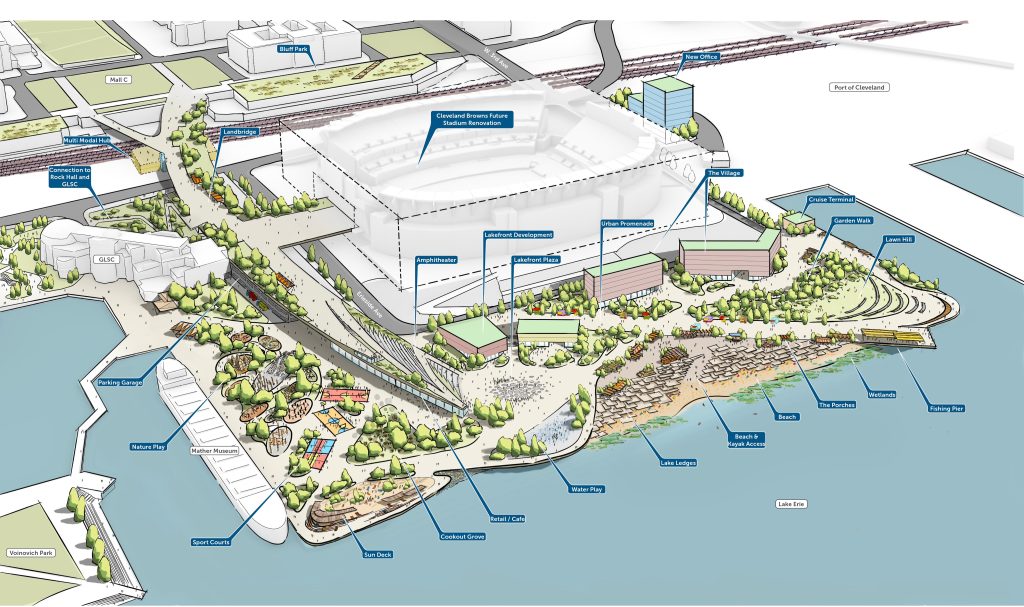
In the city’s lakefront conceptual plan released last summer, gone are the apartment towers, hotels and other big, new buildings that were in the Browns’ plan. Replacing them are publicly accessible recreational features that don’t cost much if anything to use. Cleveland Browns Stadium is shown as a placeholder here, awaiting more information from the Cleveland Browns (FO).
In another example of silence speaking loudly, Bibb’s 2024 State of the City Speech did not include one word about the Cleveland Browns Stadium situation. He didn’t say anything about the stadium in his 2023 speech either, but answered questions about it afterwards saying he wanted to “protect” the city’s general fund from the stadium project.
If it’s an economic development opportunity for the city, why does the city need to be protected from it? Because city officials apparently don’t believe a sports stadium creates more economic benefits than costs and there is data to back that up. Bibb also doesn’t want to be seen giving corporate welfare to a billionaire while one-third of Cleveland residents live in poverty.
City officials want the Downtown Cleveland lakefront to foster accessibility and social justice. That’s their call. The economic development that is desired by city officials could result from more people having equal access, the Bibb administration officials contend. That may be even more true if the football stadium is no longer there. In that case, the city gets an accessible water’s edge and another 30 acres of prime, developable land close by.
Bibb is well aware that only 15 percent of Browns game attendees reside in the city of Cleveland. Although there are surely more who are Browns fans but can’t afford to attend games, does it really matter to them if the team plays in the city of Cleveland or in Brook Park? Bibb is betting that it doesn’t.
None of this guarantees Brook Park will get the Browns, however. A new domed stadium in Brook Park is going to cost roughly twice that of a renovated lakefront stadium, or about $2.5 billion. More public-sector resources will be needed even if the public-private split stays at 50-50 regardless of where the Browns play home games.
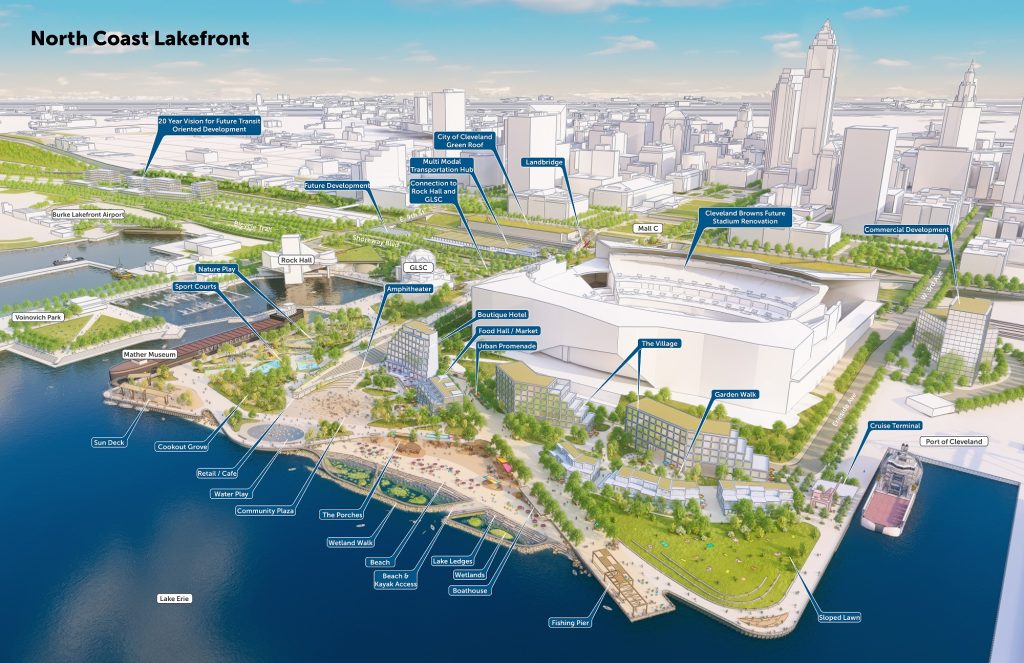
In the city’s vision for the lakefront, the western side of the stadium would have more development than the opposite side although still less than what the Cleveland Browns envisioned. Ironically, if the football stadium goes away, the city gains 30 acres of developable land in addition to a more publicly accessible waterfront (FO).
Yes, Brook Park’s tax-increment financing package would likely be larger than Cleveland’s because Brook Park would get tax revenues from the apartment towers, hotels, shops and restaurants. But that’s probably not enough value-capture for Brook Park to pay for the domed stadium. In order to cover the stadium’s larger cost (plus lots of roadway, transit and sewer infrastructure), the state is going to have to kick in hundreds of millions of dollars more.
If the state doesn’t give the Haslams what they want, they have the stadium renovation on the lakefront to fall back on. So the Haslams and the Bibb administration are staying on friendly terms and keeping the lines of communication open.
Since it takes two to three years to build a new football stadium and another year or more to design one, things are getting time-critical to where the Haslams must get some clarity from the state and other governmental jurisdictions on what they’re willing to commit to either stadium site.
The team’s lease at the city-owned Cleveland Browns Stadium expires at the end of the 2028 football season (technically February 2029). If by the end of this year the Haslams don’t get what they want from the state and/or the city of Cleveland is unwilling to let the Browns leave, say goodbye to Jimmy’s World. Say hello to Social Equity Wins by the water.
END

